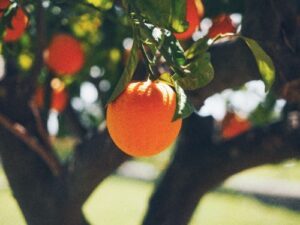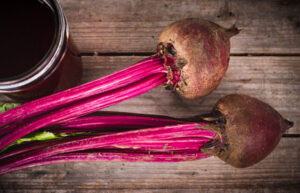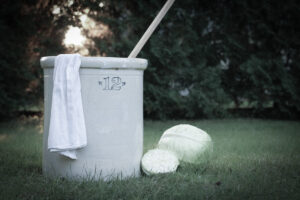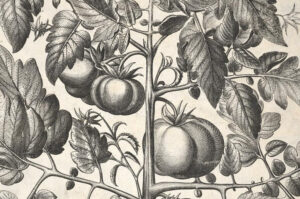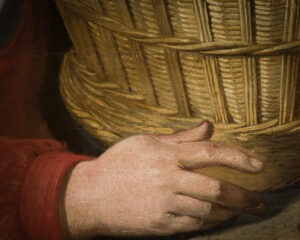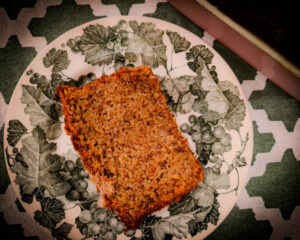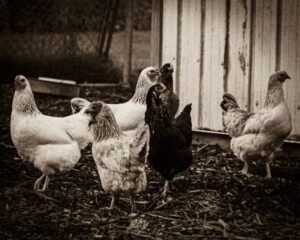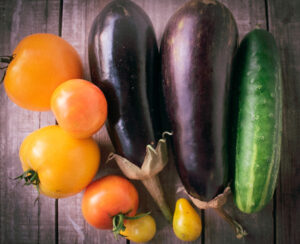Brewing Kombucha

The Beer of Health Foods
Okay, it’s not actually beer. But now that we have your attention, let’s discuss a few things: beer and kombucha are both delicious, fermented drinks that have been enjoyed for millennia. Fermentation is one of the oldest known ways to prepare and store food and drink. By using yeast and bacteria to break down and convert carbohydrates and sugars into acids and alcohols, we have been able to create a veritable palette of food and drink that speak to our ingenuity and boldness for trying new things. Beer is made from the fermentation of grains, a process through which yeast converts the sugars to ethyl alcohol and carbon dioxide, yielding the alcoholic bubbly goodness that we all know and love.
Kombucha is made by a similar process: sweet tea is fermented by a symbiotic culture of bacteria and yeast, which is known by hipsters as SCOBY and by hippies as The Mother— H&F, like the majority of modern Kombucha makers, will align itself with the hipsters (just this once). The SCOBY (Symbiotic Culture of Bacteria and Yeast) forms an amazing culture in the form of a slimy disk that floats on the top of the drink. It will continue to grow and can be used in perpetuity to ferment more and more sweet tea into kombucha. In the process, the alcoholic fermentation converts the sugar to alcohol, and the bacteria then converts most of the alcohol into various organic acids. This cycle repeats itself, and the bacteria and acids multiply into a nourishing drink that has been enjoyed for at least two-thousand years. The oldest known examples come from China and Tibet with similar stories of preserving teas into elixirs supposedly capable of granting immortality, and from the monastic west, where an over-sweetened beer was credited with saving at least one Russian emperor.
Like beer, kombucha does have many known health benefits. Unlike beer, kombucha typically has much lower (or zero) alcohol and a very high level of pro-bacteria and enzymes. Like beer, not all kombuchas are created equal and the health of your SCOBY, the selection of tea, and the source of sugar can dramatically affect taste, as can the aging process. Some kombuchas taste more like beer — earthy, complex, and rich — while others taste more vinegary (due to higher levels of acetic acid), or sweeter like champagne (due to unmetabolized sugars). An added bonus is that kombucha retains all the healthy polyphenols and powerful antioxidants that come from drinking tea. Cheers!
What You Need

Supplies:
• Large 2 gallon glass container (wide mouthed)
• 4 1-quart jars for steeping and sugar
• Dish towel to cover the top
• 20 bottles and lids, or 8 1-quart jars and lids, for final fermenting, which will take place in a few weeks.
Ingredients:
• SCOBY Culture (Symbiotic Culture of Bacteria and Yeast)
• 2 gallons of filtered water
• 24 grams of tea (Green or Black)
• 4 Cups sugar, divided 2.5 for First Fermentation, 1.5 for Secondary Fermentation
• Optional spices and flavorings
What You Do



Step #1: First fermentation
- Procure some healthy SCOBY from a friend or from a store. To prepare the SCOBY you can gently wash it in some cold water with a little vinegar.
- Boil 4 quarts of water and let cool for a few minutes (the ideal temperature depends on the tea; usually 165-185 degrees F).
- Place 12 grams of tea (10-12 tea bags) in each of 2 quart jars; steep for 10-15 minutes to make a strong tea concentrate.
- Place 1.25 cups of sugar in each of the remaining 2 quart jars, fill with hot water and stir until dissolved.
- Fill the large glass container half-way with cold or room-temperature filtered water.
- After the tea has steeped, add both the tea and the sugar water to the large glass container.
- Add the SCOBY on top. It will float or sometimes meander in the sweetened tea. Don’t worry, it will do its job, and after repeated use will create a form-fitting layer that floats on top.
- Cover the glass jar with the towel or dish towel and wrap with a string or rubber band to secure it in place.
- Store in a cool, calm and dark place.
- Keep the SCOBY wet on top by gently pushing it down with a clean spoon at least once/week.
- After two weeks, taste occasionally until the flavor is to your liking. This is pretty subjective. Fermented for a few weeks yields a sweet mild vinegar taste, while waiting longer will make it more vinegary.
Step #2: Second fermentation: Carbonation and Flavoring
- Clean bottles for second and final fermenting.
- Make some simple syrup by adding 1.5 cups of sugar to a quart jar filled with hot water.
- Carefully add at least 1 tbsp of the simple syrup per every 16oz of kombucha to each jar. Alternatively you can add 2 tbsp of sweetened juice in place of the simple syrup. You can also experiment with adding ginger, vanilla or herbs. Be creative, experiment and take good notes.
- Carefully fill the jars with the kombucha from your first batch, leaving about 1 in of headroom to allow for carbonation and tightly seal. Also, be sure to not drain the entire large container. Leave enough to feed the SCOBY and keep it moist (at least 3-4 cups). If you are not immediately making another batch of kombucha, cover the jar of SCOBY and keep in a cool, dark place and use it within a few weeks to make another batch.
Notes:
Tea Selection: Green tea is preferred; oolong and black teas are often stronger and more bitter.
Cleanliness: Keeping everything that touches the kombucha clean and sanitized will prevent any fouling or contamination.
Troubleshooting: If everything is clean, the likelihood of any fouling is remote and rare. Because this is an open fermentation, however, wild yeast strains and other contaminants can invade your kombucha. Pay attention to any evidence of mold or gnats (both of which can be easily washed away by removing your SCOBY and carefully running it under cool water. Serious and potentially harmful issues are usually pretty obvious and often include rancid smells, slime and things otherwise worse than kombucha, at which point we recommend discarding the lot and starting over.





